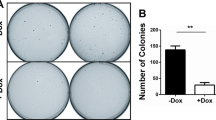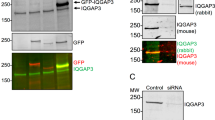Abstract
The INK4a gene, one of the most frequently disrupted loci in human cancer, encodes two unrelated proteins, p16INK4a and p19ARF, that both block cell proliferation. p16INK4a is a component of the Rb regulatory pathway, while p19ARF has been functionally related to p53. Moreover, p16INK4a is inactivated in many human tumors, while it has been very recently reported that p19ARF null mice develop tumors early in life. We show here that p19ARF is able to inhibit the formation of G418-resistant colonies when transfected into human and mouse cell lines expressing wild-type p53, regardless of p16 status. Moreover its amino terminal domain encoded by exon 1β is still sufficient to obtain the same effect. We have analysed the ability of p19ARF to interfere with Ras-mediated cellular transformation in the NIH3T3 cell line. Cotransfection of p19ARF together with activated ras potently inhibited the formation of transformed foci in a dose-dependent manner. We have also isolated stable NIH3T3 transfectants expressing p19ARF and we have measured their growth properties as well as their efficiency of transformation by activated ras. Our results suggest that p19ARF can interfere with oncogene-mediated transformation, without significantly affecting NIH3T3 cell growth, at least at the levels of expression achieved in these experiments.
This is a preview of subscription content, access via your institution
Access options
Subscribe to this journal
Receive 50 print issues and online access
$259.00 per year
only $5.18 per issue
Buy this article
- Purchase on Springer Link
- Instant access to full article PDF
Prices may be subject to local taxes which are calculated during checkout




Similar content being viewed by others
References
Arap W, Knudsen E, Sewell DA, Sidransky D, Wang JY, Huang HJ and Cavenee WK. . 1997 Oncogene 15: 2013–2020.
Calabrò V, Strazzullo M, La Mantia G, Fedele M, Paulin C, Fusco A and Lania L. . 1996 Int. J. Cancer 66: 1–6.
Haupt Y, Maya R, Kazak A and Oren M. . 1997 Nature 387: 296–299.
Kamb A, Gruis NA, Weaver-Feldhaus J, Liu Q, Harshmann K, Tavtigian SV, Stockert E, Day RS, Johnson BE and Skolnick MH. . 1994a Science 264: 435–440.
Kamb A, Shattuck-Eidens D, Eeles R, Liu Q, Gruis NA, Ding W, Hussey C, Tran T, Miki Y, Weaver-Feldhaus J, McClure M, Aitken J, Anderson DE, Bergman W, Frants R, Goldgar DE, Green A, MacLennan R, Martin NG, Meyer LJ, Youl P, Zone JJ, Skolnick MK and Cannon-Albright LA. . 1994b Nature Genet. 8: 22–26.
Kamijo T, Weber JD, Zambetti G, Zindy F, Roussel MF and Sherr CJ. . 1998 Proc. Natl. Acad. Sci. USA 95: 8292–8297.
Kamijo T, Zindy F, Roussel MF, Quelle DE, Downing JR, Ashmun RA, Grosveld G and Sherr CJ. . 1997 Cell 91: 649–659.
Kubbutat MHG, Jones SN and Vousden KN. . 1997 Nature 387: 299–303.
Ligget WH, Sewell DA, Rocco J, Ahrendt SA, Koch W and Sidransky D. . 1996 Cancer Res. 56: 4119–4123.
Mao L, Merlo A, Bedi G, Shapiro GI, Edwards CD, Rollins BJ and Sidransky D. . 1995 Cancer Res. 55: 2995–2997.
Okamoto A, Demetrick DJ, EA, S, Hagiwara K, Hussain SP, Bennet WP, Forrester K, Gerwin B, Serrano M, Beach DH and Harris CC. . 1994 Proc. Natl. Acad. Sci. USA 91: 11045–11049.
Oliner JD, Kinzler KW, Meltzer PS, Gerge DL and Vogelstein B. . 1992 Nature 358: 80–83.
Pomerantz J, Schreiber-Agus N, Liegeois NJ, Silverman A, Alland L, Chin L, Potes J, Chen K, Orlow I, Lee HW, Cordon-Cardo C and DePinho RA. . 1998 Cell 92: 713–723.
Quelle DE, Cheng M, Ashmun RA and Sherr CJ. . 1997 Proc. Natl Acad. Sci. USA 94: 669–673.
Quelle DE, Zindy F, Ashmun RA and Sherr CJ. . 1995 Cell 83: 993–1000.
Serrano M, Gomez-Lahoz E, DePinho RA, Beach D and Bar-Sagi D. . 1995 Science 267: 249–252.
Sherr CJ and Roberts JM. . 1995 Genes Dev. 9: 1149–1163.
Spillare EA, Okamoto A, Hagiwara K, Demetric DJ, Serrano M, Beach D and Harris CC. . 1996 Mol. Carcin. 16: 53–60.
Stone S, Jiang P, Dayananth P, Tavtigian SV, Katcher H, Parry D, Peters G and Kamb A. . 1995 Cancer Res. 55: 2988–2994.
Zhang Y, Xiong Y and Yarbrough WG. . 1998 Cell 92: 725–734.
Acknowledgements
We would like to thank Miss R Terracciano for skillful technical help. We are grateful to Dr A Sacchi for supplying the Saos 2 and U-2OS cell lines. TP is a recipient of a predoctoral fellowship cofinanced by the `Fondo sociale Europeo' (EEC) and this work is in partial fulfillment of the requirements for the doctoral degree in Genetics at the University of Naples. This work was paid for by grants from the Italian Association for Cancer Research (AIRC) and MURST.
Author information
Authors and Affiliations
Rights and permissions
About this article
Cite this article
Calabrò, V., Parisi, T., Cristofano, A. et al. Suppression of Ras-mediated NIH3T3 transformation by p19ARF does not involve alterations of cell growth properties. Oncogene 18, 2157–2162 (1999). https://doi.org/10.1038/sj.onc.1202532
Received:
Revised:
Accepted:
Published:
Issue Date:
DOI: https://doi.org/10.1038/sj.onc.1202532
Keywords
This article is cited by
-
PKC Dependent p14ARF Phosphorylation on Threonine 8 Drives Cell Proliferation
Scientific Reports (2018)



